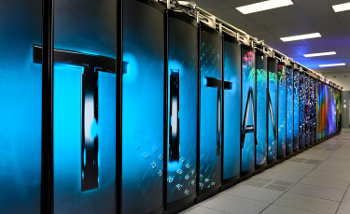Titan Supercomputer
November 19, 2012
In a
previous article (Special K, June 23, 2011), I wrote about the fastest computer at that time, the
K Computer of the
RIKEN Advanced Institute for Computational Science,
Kobe, Japan. This computer was benchmarked at 8.2
petaflop, and the ten fastest computers at that time all achieved petaflop performance.[1] Compare that with the 80 megaflop performance of one of the first
supercomputers, the venerable
Cray-1.
There will always be another, faster computer, and there's an organization dedicated to cataloging supercomputing progress. Supercomputer rankings are posted every six months in the
TOP500 List of the fastest supercomputers.[2] The ranking is determined by the computers' speed of execution of the
Linpack benchmark suite. I wrote about Linpack in a
previous article (Benchmarks, November 17, 2010).
November's release of its 40th list marked the Top 500's 20th anniversary. Here's a summary of the current top ten.[2] The list shows that maximum computing speed has jumped from 8.2 to 17.6 petaflops in just eighteen months. It's interesting to note that the second ranked computer has more
cores and a higher
clock rate than the first, which proves that
system architecture is as important as the
hardware.
As seen in the list, the
Oak Ridge National Laboratory Titan computer is the fastest in the world (except, perhaps, for some
NSA computers about which we have no information).[3-10] One important note is the
power required for such speed. The Titan supercomputer draws 8.2
megawatts, which is surprisingly lower than the K computer's 12.66 megawatts. When you model
climate change with one of these, you're changing the
climate at the same time! A megawatt translates to hundreds of
dollars per hour operating cost.

Computation sometimes leads to a headache, as the leftmost figure demonstrates.
The Titans, as illustrated by Gustave Doré (1832 - 1883) in Dante's Inferno (Plate LXV: Canto XXXI).
(Via Wikimedia Commons))
As described in an ORNL press release, the computing power of the Titan is equivalent to each of the
Earth's seven billion inhabitants doing three million
calculations per second.[4] These aren't simple calculations, but ones that would put so-called
long division to shame. Humans, however, should be proud that we're still the only
intelligent lifeforms on the planet,
at least for a few more years (My apologies to the
dog owners,
dolphin lovers, etc., who may object to my saying that
humans are Earth's only intelligent lifeform).
There's a trend towards the use of
Graphics processing unit (GPU) chips in computing applications. There are sixty-two supercomputers on the current top-500 list using GPUs to increase speed and
efficiency. In the top-10, these include the Titan and the Chinese Tianhe-1A. Both systems use
Nvidia GPUs.[3] Says ORNL associate
laboratory director for computing and computational sciences,
Jeffrey A. Nichols,
"One challenge in supercomputers today is power consumption... Combining GPUs and CPUs in a single system requires less power than CPUs alone and is a responsible move toward lowering our carbon footprint."[4]

That's one hot supercomputer.
The ORNL Titan supercomputer consumes 8.2 megawatts of power.
(ORNL Image))
Titan is actually an upgrade of an ORNL supercomputer called
Jaguar, the upgrade being essentially a replacement of its six-core
AMD Opteron CPUs to 16-core, plus an integration of
Nvidia Tesla K20 GPUs into the system to increase computing performance by a factor of ten.[4-5] A GPU was added to each of the 18,688 AMD Opteron CPU chips.[7] Titan contains more than 700
terabytes of memory,and sits on 20,000
square feet of floor area. There's enough brute-force cooling that
ear protection is required if working more than fifteen minutes in Titan's proximity.[4,7]
Supercomputing won't stop at the 10-petaflop stage. The US Department of Energy is planning an
exascale system, one that performs at 10
18 flops, for 2018.[5] ORNL's Jeffrey Nichols, as quoted at datacenterknowledge.com, explains,
"We envision two systems beyond Titan to achieve exascale performance by about 2018... The first will be an order of magnitude more powerful than Titan, in the range of 200 petaflops. This system will be an exascale prototype, incorporating many of the hardware approaches that will be incorporated at the exascale. We hope to scale this solution up to the exascale."[5]
Power-wise, exascale won't be that easy to reach.
Wu Feng, who curates the
Green-500 list of the most energy-efficient supercomputers, says that an exascale computer will require 50 megawatts if current efficiency trends continue.[7] The DOE's goal is 20 megawatts, or less, so new chip types will be required. Also, interconnection between subsystems would need to be
fibreoptic.[7]
The US now hosts half of the computers on the Top-500, with
Europe having 105, and
Asia 124.[3] The
BBC states that supercomputing has joined
theory and
experiment to become the "third pillar" of doing
science.[7]
References:
- Erich Strohmaier, "Japan Reclaims Top Ranking on Latest TOP500 List of World's Supercomputers," TOP500 Press Release, June 16, 2011.
- Top 500 Supercomputers Web Site.
- Oak Ridge Claims No. 1 Position on Latest TOP500 List with Titan, TOP500 Press Release, Nov. 12, 2012.
- ORNL Debuts Titan Supercomputer. Oak Ridge National Laboratory Press Release, Oct. 29, 2012.
- Rich Miller, "Oak Ridge: The Frontier of Supercomputing," Data Center Knowledge, September 10, 2012.
- John Pavlus, "Building Titan: The ‘world's fastest’ supercomputer," BBC, October 29, 2012.
- US Titan supercomputer clocked as world's fastest, BBC November 12, 2012.
- Christopher Williams,"'Titan' supercomputer is world's most powerful," Telegraph (UK), 12 November 12, 2012.
- Michael Feldman, "Titan Sets High Water Mark for GPU Supercomputing," HPC Wire, October 29, 2012.
- Titan Web Site.
Permanent Link to this article
Linked Keywords: K Computer; RIKEN Advanced Institute for Computational Science; Kobe, Japan; petaflop; supercomputer; Cray-1; TOP500 List; Linpack; multi-core processor; core; clock rate; system architecture; computer hardware; United States; United States Department of Energy; DOE; Oak Ridge National Laboratory; ORNL; Titan supercomputer; Lawrence Livermore National Laboratory; LLNL; IBM Sequoia; Japan; RIKEN; Argonne National Laboratory; IBM Mira; Germany; Forschungszentrum Juelich; JUQUEEN; Leibniz Rechenzentrum; SuperMUC; University of Texas; Stampede; China; Tianjin National Supercomputing Center; Tianhe-1A; Italy; CINECA; Fermi; IBM Development Engineering; DARPA; National Security Agency; NSA; electric power; megawatt; climate change; climate; dollar; Titans; Gustave Doré; Dante's Inferno; Dante Alighieri; Wikimedia Commons; Earth; world population; seven billion inhabitants; calculation; long division; intelligence; intelligent; technological singularity; dog; dolphin; human; graphics processing unit; GPU; efficiency; Nvidia; laboratory; director; Jeffrey A. Nichols; Jaguar; AMD Opteron; Nvidia Tesla K20 GPU; terabyte; square foot; square feet; hearing protection; exascale computing; exascale system; Wu Feng; Green-500; fibreoptic; Europe; Asia; BBC; theory; experiment; science.